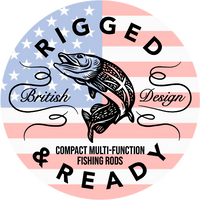About Fishing Rods/Poles
Finding the right fishing rod can be overwhelming when there are so many options available. The selection process can be challenging, yet proper guidance will help you identify the fishing rod that aligns with your preferred fishing method. We provide a simple way for you to discover the exact fishing rod that matches your preferences, including spinning rods, casting rods, and more.
All anglers require fish rods or fishing poles, which serve to throw and handle the line when catching fish. The right fishing rods determine success regardless of fishing experience and from novice to expert anglers. Various fishing needs find their ideal equipment since casting rods offer strength while spinning rods provide lightweight performance.
How to Choose a Fishing Pole/Rod
The fishing technique together with target species and skill level determine which fishing rod you should use. Novice anglers should opt for spinning rods, yet experienced anglers will benefit from casting rods. The fishing pole's suitability for your needs depends on the three elements of length and material composition and flexibility level. Your selection of a fishing rod should balance durability with performance when making purchases.
Types of Fishing Rods
Many fishing poles exist to fulfill specific fishing techniques. Several popular rod types exist according to the information below:
-
Spinning Rods: Best for beginners, offering ease of use and versatility.
-
Casting Rods: Ideal for experienced anglers targeting larger fish, providing better precision.
-
Fly Rods: Designed for fly fishing, featuring lightweight construction for smooth casting.
-
Telescopic Rods: Perfect for travelers, these rods collapse for portability.
Key Components of a Fishing Rod or Fishing Pole
Knowing the main parts of a fishing rod facilitates the choice of appropriate equipment for your needs.
-
Rod Blank: The fishing pole's basic construction determines strength and flexibility. It’s made from materials like graphite or fibreglass for durability.
-
Guides: Small rings attached to the rod’s length function as guides to direct fishing lines. The guides provide smooth casting and retrieval operations while reducing the amount of friction between components.
-
Reel Seat: The fishing rod section that allows reel attachment is known as the reel seat. The grip should be made from strong materials that provide a reliable holding point.
-
Handle/Grip: It dictates your fishing pole's comfort of use. It also comes from materials like EVA foam or cork for a strong hold.
Frequently Asked Questions
Q) Which fishing rod is best for general fishing?
A spinning rod is the best all-around option. It’s easy to use, versatile, and works in most fishing conditions. If you need more precision and control, consider a casting rod.
Q) How much does a good fishing rod cost?
The material and quality of a fishing rod affect its price. While a professional fishing rod can run over $150 USD, entry-level fish rods start at $40 USD.
Q) Do expensive rods make a difference?
Of course, expensive fishing rods have much better sensitivity, durability, and casting accuracy. For a casual angler, however, a middle-range rod can also perform remarkably!
Q) What is a good beginner fishing rod?
Beginning users would want a spinning rod since it is flexible and easy to use. To strike a mix between strength and flexibility, search for a medium-action fishing pole.
Q) Is it a fishing rod or pole?
Although people interchangeably use these terms a fishing pole refers to a simple rod without a reel whereas a fishing rod includes a reel that enables both casting and retrieving operations.





